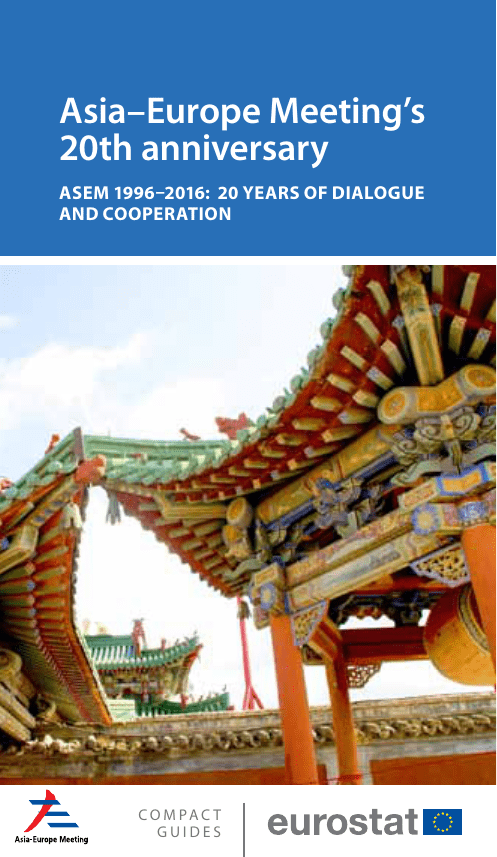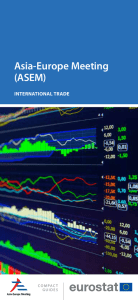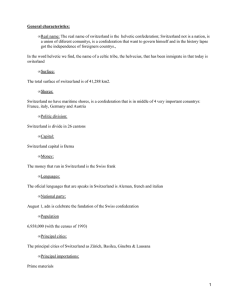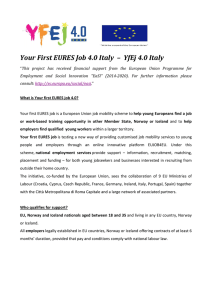Asia–Europe Meeting`s 20th anniversary
Anuncio

Asia–Europe Meeting’s 20th anniversary ASEM 1996–2016: 20 years of dialogue and cooperation co m pac t g u i d es The Asia-Europe Meeting celebrates 20 years of dialogue and cooperation The first ASEM Summit was held on 1-2 March 1996. It marked the start of a process that engaged both regions in dialogue and cooperation on political, economic and socio-cultural issues. The origins of the ASEM process lay in the recognition that the relationship between the two regions, Asia and Europe, could be strengthened. For the past 2 decades ASEM has played a pivotal role as a forum for dialogue and cooperation. ASEM celebrates its 20th anniversary on 15-16 July 2016 at the 11th ASEM Summit (ASEM11) in Ulaanbaatar, Mongolia. Managing growing Europe-Asia relations ASEM was established as a new process between Asia-Europe, complementing existing Europe-Asia relations. ASEM is not a substitute for other bilateral or multilateral forums between Asia and Europe, and it can help to facilitate and stimulate progress in other forums. As a new layer of dialogue and cooperation, ASEM has enhanced synergies in Europe-Asia relations and served as catalyst for overall Asia-Europe relations. ASEM has helped Europe and Asia to have a more global vision of the two regions. By remaining an informal dialogue-based process, ASEM aims to promote overall Asia-Europe relations on international and inter-regional issues of common interest. By bringing together different cultures and civilisations, ASEM is a unique process to foster common understanding and dialogue. From the initial Summit with 26 partners, ASEM now brings together 51 countries and 2 international institutions. This growth has taken place in several stages. Partly, it has followed naturally through the enlargement of the European Union and ASEAN, partly additional countries have seen the value of joining in this fruitful process. The following illustrations present the current ASEM partners and show the development in ASEM membership over these 20 years. Today, almost two thirds of the world population is living in countries participating in the ASEM process. Over the last 20 years, the population living in ASEM partner countries has grown from just under 2.2 billion in 1996 to 4.5 billion in 2014, (the most recent year for which data are available). Social and economic progress Across the ASEM partners, data show that there has been a trend over the last 20 years for people to move from the countryside into cities, in particular into cities with more than one million inhabitants, most notably among the Asian ASEM partners. This trend reinforces and creates new social challenges that are common to all ASEM partners, calling for exchange of experiences and solutions. While there are variations in the share of the population at school age or below (0-14 years) across the ASEM partners, it is interesting to note that the share of the population of working age (15-64 years) is relatively similar between the regions. It is notable how much the GDP in the ASEM partners has grown since 1996, both in total and measured per inhabitant. The data also reflect the rapid emergence of the ‘information society’, with rapid growth in both mobile phone and internet usage. Asia-Europe Meeting partners: European Union Member States: Belgium, Bulgaria, Czech Republic, Denmark, Germany, Estonia, Ireland, Greece, Spain, France, Croatia, Italy, Cyprus, Latvia, Lithuania, Luxembourg, Hungary, Malta, Netherlands, Austria, Poland, Portugal, Romania, Slovenia, Slovakia, Finland, Sweden and United Kingdom Other European partners: Norway and Switzerland ASEAN member states: Brunei Darussalam, Cambodia, Indonesia, Lao PDR, Malaysia, Myanmar, Philippines, Singapore, Thailand and Viet Nam Northeast and South Asia (NESA) partners: Australia, Bangladesh, China, India, Japan, Kazakhstan, Republic of Korea, Mongolia, New Zealand, Pakistan and Russian Federation International institutions: European Union and ASEAN Secretariat Number of ASEM partners at each enlargement 60 50 2 1 40 2 2 10 9 6 3 30 20 10 0 10 1 3 7 10 10 2 11 10 10 2 2 27 27 27 28 2008 2010 2012 2014 25 15 1996 2004 EU Norway and Switzerland ASEAN NESA Intl. organisations (1) (1) European Union from 1996 onwards; ASEAN Secretariat from 2008 onwards Source: ASEM Infoboard Surface area of ASEM at each enlargement (million square kilometres) 60 50 40 30 20 10 0 1996 2004 EU 2008 (1) 2010 Norway and Switzerland (2) ASEAN 2012 2014 NESA (1) 2008: Major enlargement, including India; (2) Norway and Switzerland are ASEM members since 2012 Source: ASEM Infoboard Share of ASEM in the world population (1) (%) 70 60 60 62 50 40 38 37 38 1996 2001 2006 30 20 10 0 2011 2014 (1) Total ASEM population corresponds to the population of the countries who were ASEM partners in the year in question Source: World Bank World Development indicators Unemployment rate in ASEM, 1996–2014 (% of the labour force) 12 10 8 6 4 2 0 1996 1997 1998 1999 2000 2001 2002 2003 2004 2005 2006 2007 2008 2009 2010 2011 2012 2013 2014 ASEM EU Norway and Switzerland (1) ASEAN NESA (1) Norway and Switzerland are ASEM members since 2012 Source: International Labour Organization Share of ASEM population aged 0 to 14 years, 2014 (% of total population) 30 25 27 23 23 20 16 16 EU Norway and Switzerland 15 10 5 0 ASEM ASEAN NESA Source: World Bank World Development indicators Share of ASEM population of working age (aged 15 to 64 years), 2014 (% of total population) 80 70 68 66 67 67 EU Norway and Switzerland ASEAN 69 60 50 40 30 20 10 0 ASEM Source: World Bank World Development indicators NESA Share of urban population in ASEM, 1996–2014 (% of total population) 90 80 70 60 50 40 30 20 10 0 1996 1997 1998 1999 2000 2001 2002 2003 2004 2005 2006 2007 2008 2009 2010 2011 2012 2013 2014 ASEM EU Norway and Switzerland (1) ASEAN NESA (1) Norway and Switzerland are ASEM members since 2012. Source: United Nations, World Urbanization Prospects Population in cities with more than 1 million inhabitants in ASEM, 1996–2014 (% of total population) 25.0 22.5 20.0 17.5 15.0 12.5 10.0 7.5 5.0 2.5 0.0 1996 1997 1998 1999 2000 2001 2002 2003 2004 2005 2006 2007 2008 2009 2010 2011 2012 2013 2014 ASEM EU Norway and Switzerland (1) ASEAN NESA (1) Norway and Switzerland are ASEM members since 2012. Source: United Nations, World Urbanization Prospects Mobile phone penetration in ASEM, 1996–2014 (subscriptions per thousand inhabitants) 1 400 1 200 1 000 800 600 400 200 0 1996 1997 1998 1999 2000 2001 2002 2003 2004 2005 2006 2007 2008 2009 2010 2011 2012 2013 2014 ASEM EU Norway and Switzerland (1) ASEAN NESA (1¹) Norway and Switzerland are ASEM members since 2012 Source: International Telecommunication Union Internet users in ASEM, internet use in the last 12 months, 1996–2014 (% of the population) 100 90 80 70 60 50 40 30 20 10 0 1996 1997 1998 1999 2000 2001 2002 2003 2004 2005 2006 2007 2008 2009 2010 2011 2012 2013 2014 ASEM EU Norway and Switzerland (1) ASEAN NESA (1) Norway and Switzerland are ASEM members since 2012 Source: Eurostat (online data code: isoc_ci_ifp_iu) for EU, Norway and Switzerland; International Telecommunication Union for other ASEM partners ASEM gross domestic product at market prices, by enlargement round (billion current EUR) 35 000 30 000 25 000 20 000 15 000 10 000 5 000 0 1996 EU (1) 2004 2008 2010 Norway and Switzerland (2) 2012 ASEAN (3) 2014 NESA (1) Malta not available for 2014; (2) Norway and Switzerland are ASEM members since 2012; (3) Myanmar only available from 2012 onwards Source: World Bank national accounts data, OECD national accounts data GDP per capita in ASEM, 1996 and 2014 (current USD) 9 916 36 403 2014 90 109 4 044 6 693 7 391 24 908 1996 1 677 4 443 0 10,000 20,000 30,000 40,000 50,000 60,000 70,000 80,000 90,000 100,000 ASEM EU (1) Norway and Switzerland (2) ASEAN (3) NESA (1) Malta not available for 2014; (2) Norway and Switzerland are ASEM members since 3 2012; ( ) Myanmar not available for 1996 Source: WorldBank national accounts data and OECD national accounts data The future of the Asia-Europe Meeting (ASEM) Looking ahead into ASEM’s third decade The future of the Asia-Europe Meeting (ASEM): Looking ahead into ASEM’s third decade KS-01-16-543-EN-N Asia-Europe Meeting (ASEM) For information on the Asia-Europe Meeting: ASEM Infoboard: http://www.aseminfoboard.org This project is funded by the European Union ASEM At 20 the challenge of connectivity ASEM at 20: The challenge of connectivity Autumn 2015 Media partner With the support of Eurostat cooperation resources For information on Eurostat’s statistical cooperation activities: http:// ec.europa.eu/eurostat/web/international-statistical-cooperation/ overview E-mail: [email protected] Asia-Europe meeting (ASEM) A stAtisticAl portrAit 2016 edition Asia-Europe Meeting A statistical portrait 2016 edition ISSN 2315-0815 Essential SNA: Building the basics 2014 edition Essential SNA: Building the basics 2014 edition s tat i s t i c a l books Compact guides Snapshot A user-friendly tool to assess the strengths and weaknesses of National Statistical Systems Snapshot A user-friendly tool to assess National Statistical Systems Guide to statistics in European Commission development cooperation 2013 edition See ‘Statistics explained’ for further insight into Eurostat’s international cooperation activities: http://ec.europa.eu/eurostat/statistics-explained/index.php/NonEU_countries See in particular the article ‘Asia-Europe Meeting (ASEM) - a statistical portrait - key facts’ http://ec.europa.eu/eurostat/statistics-explained/index.php/AsiaEurope_Meeting_%28ASEM%29_-_a_statistical_portrait_-_key_facts See also European External Action Service (EEAS): http://eeas.europa.eu ISBN 978-92-79-58771-9 doi:10.2785/34709 © European Union, 2016 Cover: © shutterstock.com


